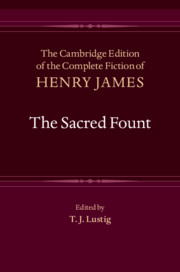Book contents
- Frontmatter
- Contents
- List of Illustrations
- Acknowledgements
- List of Abbreviations
- General Editors’ Preface
- General Chronology of James’s Life and Writings
- Introduction
- Contemporary Reception of The Sacred Fount
- Textual Introduction
- Chronology of Composition and Production
- Bibliography
- The Sacred Fount
- Glossary of Foreign Words and Phrases
- Notes
- Textual Variants
- Emendations
Introduction
Published online by Cambridge University Press: 11 April 2021
- Frontmatter
- Contents
- List of Illustrations
- Acknowledgements
- List of Abbreviations
- General Editors’ Preface
- General Chronology of James’s Life and Writings
- Introduction
- Contemporary Reception of The Sacred Fount
- Textual Introduction
- Chronology of Composition and Production
- Bibliography
- The Sacred Fount
- Glossary of Foreign Words and Phrases
- Notes
- Textual Variants
- Emendations
Summary
on 17 February 1894, the 50-year-old Henry James attended a function at 65 Rutland Gate, Knightsbridge, less than a mile away from his flat at 34 De Vere Gardens in Kensington. This London dinner, which took place in what James later described as an ‘immaculate & lovable house’, was held by the literary hostess Blanche Alethea Crackanthorpe (1846–1928) and her husband, the barrister Montague Hughes Crackanthorpe (1832–1913). At some point during the evening, James encountered Stopford Brooke (1832–1916), the Irish-born man of letters and former cleric. The novelist mentioned their conversation in his notebook: ‘[l]ast night, at Mrs. Crackanthorpe’s, Stopford Brooke suggested to me 2 little ideas.’ The first of these ideas – that of a man ‘who has become afraid of himself when alone’ – never came to anything, though James reverted to it in his notebook on 16 May 1899 and 11 September 1900. The second idea, however, prompted immediate elaboration:
The notion of the young man who marries an older woman and who has the effect on her of making her younger and still younger, while he himself becomes her age. When he reaches the age that she was (on their marriage,) she has gone back to the age that he was.—Mightn't this be altered (perhaps,) to the idea of cleverness and stupidity? A clever woman marries a deadly dull man, and loses & loses her wit as he shows more & more. Or the idea of a liaison, suspected, but of which there is no proof but this transfusion of some idiosyncrasy of one party to the being of the other—this exchange & conversion? The fact, the secret, of the liaison might be revealed in that way. The two things—the two elements—beauty & “mind,” might be correspondingly, concomitantly exhibited as in the history of two related couples—with the opposition, in each case, that wd. help the thing to be dramatic[.] (CN 88)
This is the first glimpse of a novel which, for one contemporary reviewer, was ‘wellnigh unbelievable in its irrelevance’ and, for another, ‘an example of hypochondriachal subtlety run mad’ – a novel which, for a subsequent generation of critics, became an instance of ‘unassailable mastery’ and even ‘the first authentic masterpiece of the “modern movement”’.
- Type
- Chapter
- Information
- The Sacred Fount , pp. xxvi - lxxxviiiPublisher: Cambridge University PressPrint publication year: 2019

